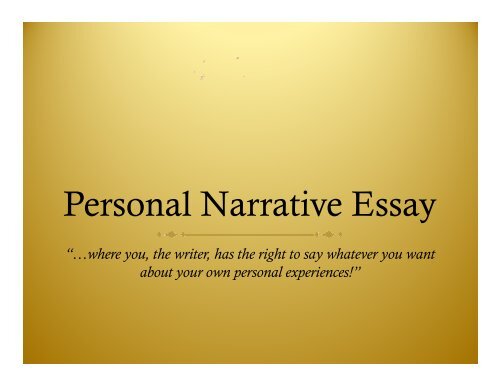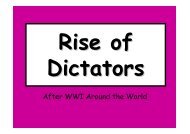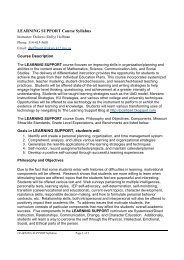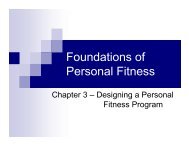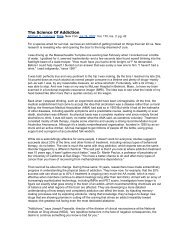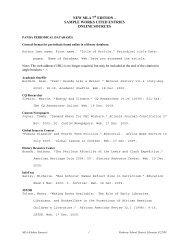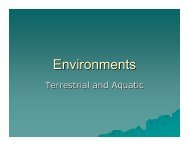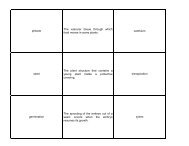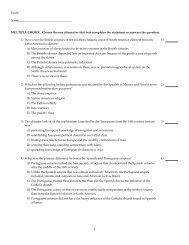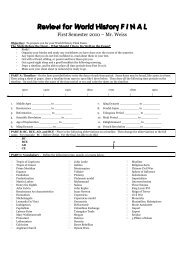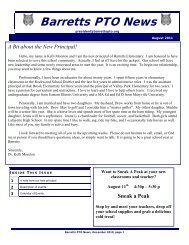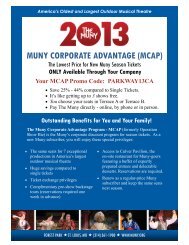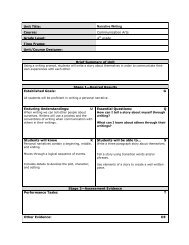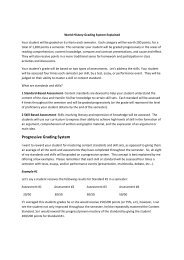Personal Narrative Essay PowerPoint
Personal Narrative Essay PowerPoint
Personal Narrative Essay PowerPoint
You also want an ePaper? Increase the reach of your titles
YUMPU automatically turns print PDFs into web optimized ePapers that Google loves.
<strong>Personal</strong> <strong>Narrative</strong> <strong>Essay</strong><br />
“…where you, the writer, has the right to say whatever you want<br />
about your own personal experiences!”
Very Little Mystery<br />
There is no “perfect topic” for a personal narrative essay<br />
You can write about anything that shows how the past or<br />
the significance of a memory affects the present or future<br />
There are endless opportunities to write about your<br />
personal point of view of what happened.<br />
The purpose of the <strong>Personal</strong> <strong>Narrative</strong> <strong>Essay</strong> is very<br />
specific: the writer is searching for meaning, universal<br />
truth, or a lesson learned from the experience being<br />
described.
Purpose of PNE<br />
The purpose of the <strong>Personal</strong> <strong>Narrative</strong> <strong>Essay</strong> is very specific:<br />
the writer is searching for meaning, universal truth, or a lesson<br />
learned from the experience being described.<br />
<strong>Personal</strong> narrative essays are non-fiction stories that are neatly<br />
arranged like a road map that takes the reader from point A to<br />
point B to point C.<br />
Your job, as the writer, is to pull together all the elements of<br />
your experience so they bring the reader to the universal truth,<br />
the lesson learned or insight gained in your experience<br />
(theme)
Let Your Theme SHINE!<br />
Revise, revise, revise!-Each time you revise your essay, more<br />
details about your story will be revealed to you, making your<br />
theme more evident.<br />
Arrange your events in a chronological sequence that leads to<br />
your ah-ha (epiphany).<br />
Strive to reach your ah-ha (epiphany) moment because once<br />
you do, dramatic improvement will show in future revisions.<br />
Think of examples that will better illustrate your ah-ha by<br />
using figurative language, sensory details, precise parts of<br />
speech and other types of descriptive language. Keep the Six<br />
Traits of Writing in mind and use the Five Brushstrokes to<br />
help you fluently paint your picture.
How to Get Started<br />
Choose a theme: What is the universal truth? Lesson learned?<br />
Insight gained?<br />
Choose an aha! (epiphany): What did you suddenly realize as<br />
a result of this experience? Describe the emotions you had<br />
during this experience to your readers. Make sure they can<br />
really feel it.<br />
Write “I” on a blank sheet of paper. “I” empowers you to tell<br />
your story. (I saw, I did, I went, I cried, I screamed, I took for<br />
granted etc)<br />
Tell the story as it flows from your mind. Get it all out first!
Oh no! I’m stuck!<br />
Don’t panic!<br />
Stop writing! Don’t force it!<br />
Read other essays! Surround yourself with excellent<br />
essays!<br />
Get feedback!<br />
Go back to working on your essay!
The Five Prompts…<br />
1. What matters to me most…<br />
2. I wonder…<br />
3. What makes a great teacher?<br />
4. Choose three significant events and their effect on your life<br />
5. Have you ever been bullied, been a bully, or witnessed<br />
bullying? How did this affect you?<br />
Which one did you pick? Please take it out and place it on your<br />
desk.
How to reach your aha!<br />
Ask yourself the following questions:<br />
1. What is the one thing you know and how do you know it?<br />
2. What have you done and what has that shown you?<br />
3. What have you seen and what do you think about it?<br />
4. Where are you now and how did you get there?<br />
5. What is one thing you think and what has led you to think<br />
that?<br />
6. What is one thing you believe and how did that belief evolve?
PNE Paragraphs<br />
Introduction<br />
Body (think of how many paragraphs you’ll need)<br />
Conclusion
Introduction<br />
(9-11 sentences)<br />
Definition-the first paragraph of your essay that is<br />
supposed to grab the attention of your reader.<br />
Tell your reader about the subject you’re going to discuss.<br />
Avoid revealing too many details in this paragraph.<br />
Inform the reader about your theme and your experience<br />
Give reasons why the story you are sharing is significant
Body<br />
Tell the story of your thinking through your structure.<br />
Example:<br />
What I used to think but this happened so now I think<br />
So, you will have one paragraph about each box, in sequential order of<br />
course:<br />
Paragraph #1: What I used to think<br />
Paragraph #2: but this happened<br />
Paragraph #3: so now I think
Conclusion<br />
Brings the essay to a close<br />
Wrap-up by summarizing the essay, rhetorical question<br />
or plans for the future<br />
Remind readers of the theme<br />
Leave your readers with a feeling that they need to sit<br />
back and think about what you brought up<br />
Leave readers with a surprise, an intense emotion or<br />
even a twist ending!


